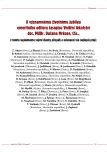Management of the diabetic patient with coronary artery disease
Authors:
P. Mikeš; J. Murín
Authors‘ workplace:
I. interná klinika Lekárskej fakulty UK a FNsP Bratislava, Slovenská republika, prednostka doc. MUDr. Soňa Kiňová, Ph. D.
Published in:
Vnitř Lék 2009; 55(Suppl 1)(Supplementum 1): 97-102
Overview
The prevalence of 2 type diabetes in the world as a consequence of modern urban lifestyle is convincingly growing. Diabetes together with other risk factors for cardiovascular disease creates a part of metabolic syndrome. Diabetic cardiomyopathy is defined as heart failure in diabetic patient without any other known reason and an impairment of myocardial metabolism with preference of less efficient free fatty acids beta oxidation in generating ATP is typical for it. The main goal in the management of diabetic patient with CAD is to prevent macro‑ and microvascular complications and improve the prognosis of the patient. To achieve this we need a multifactorial approach concerning lifestyle modification, medical therapy and strict control of glycaemia.
Key words:
diabetic cardiomyopathy – coronary artery disease – management
Sources
1. Amos AF, McCarty DJ, Zimmet P. The rising global burden of diabetes and its complications: estimates and projections to the year 2010. Diabet Med 1997; 14 (Suppl 5): S1–S85.
2. Alberti KG, Zimmet PZ. Definition, diagnosis and classification of diabetes mellitus and its complications. Part 1: diagnosis and classification of diabetes mellitus provisional report of WHO consultation. Diabet Med 1998; 15: 539–553.
3. Haffner SM, Lehto S, Rönnemaa T et al. Mortality from coronary heart disease in subjects with type 2 diabetes and in nondiabetic subjects with and without prior myocardial infarction. N Engl J Med 1998; 339: 229–234.
4. James SK, Lindahl B, Timmer JR et al. Usefulness of biomarkers for predicting long‑term mortality in patients with diabetes mellitus and non‑ST‑elevation acute coronary syndromes (a GUSTO IV substudy). Am J Cardiol 2006; 97: 167–172.
5. American Diabetes Association: standards of medical care for patients with diabetes mellitus (position statement). Diabetes Care 2002; 25: 213–229.
6. Cooper S, Caldwell JH. Coronary artery disease in people with diabetes: diagnostic and risk factor evaluation. Clin diabetes 1999; 17: 58–72.
7. Kaski JC. Dietary management of coronary artery disease and type 2 diabetes mellitus. London, UK: The European Cardiologist 2004.
8. Smith SC Jr, Blair SN, Bonow RO et al. AHA/ACC Scientific statement. AHA/ACC Guidelines for preventing heart attack and death in patients with atherosclerotic cardiovascular disease: 2001 update. A statement for healthcare professionals from the American Heart Association and the American College of Cardiology. Circulation 2001; 104: 1577–1579.
9. Laakso M. Cardiovascular disease in type 2 diabetes: challenge for treatment and prevention. J Intern Med 2001; 249: 225–235.
10. Klein L, Gheorghiade M. Management of the patient with diabetes mellitus and myocardial infarction: clinical trials update. Am J Med 2004; 116 (Suppl 5A): 47S–63S.
11. Braun S, Boyko V, Behar S et al. Calcium antagonists and mortality in patients with coronary artery disease: a cohort study of 11,575 patients. J Am Coll Cardiol 1996; 28: 7–11.
12. Fragasso G, Piatti Md PM, Monti L et al. Short- and long‑term beneficial effects of trimetazidine in patients with diabetes and ischemic cardiomyopathy. Am Heart J 2003; 146: E18.
13. Kasiske BL, Kalil RS, Ma JZ et al. Effect of antihypertensive therapy on the kidneys in patients with diabetes: a metaregression analysis. Ann Intern Med 1993; 118: 129–138.
14. Yusuf S, Zhao F, Mehta SR et al. Effects of clopidogrel in addition to aspirin in patients with acute coronary syndromes without ST segment elevation. N Engl J Med 2001; 345: 494–502.
15. Bartnik M, Rydén L, Ferrari R et al. Euro Heart Survey Investigators. The prevalence of abnormal glucose regulation in patients with coronary artery disease across Europe. Eur Heart J 2004; 25: 1880–1890.
16. Tamita K, Katayama M, Takagi T et al. Impact of newly diagnosed abnormal glucose tolerance on long‑term prognosis in patients with acute myocardial infarction. Circ J 2007; 71: 834–841.
17. Bartnik M, Malmberg K, Norhammar A et al. Newly detected abnormal glucose tolerance: an important predictor of long term outcome after an acute myocardial infarction. Eur Heart J 2004; 25: 1990–1997.
18. Adler AI, Stratton IM, Neil HA et al. Association of systolic blood pressure with macrovascular and miacrovascular complications of type 2 diabetes (UKPDS 36): prospective observational study. BMJ 2000; 321: 412–419.
19. Dagenais GR, Yusuf S, Bourassa MG et al. Effects of ramipril on coronary events in high risk persons : result of the Heart Outcomes Prevention Evaluation Study. Circulation 2001; 104: 522–526.
20. Fox KM. Efficacy of perindopril in reduction of cardioascular events among patients with stable coronary artery disease: randomised, double-blind, placebo-controlled, multicentre trial (the EUROPA study). Lancet 2003; 362: 782–788.
21. Wallhaus TR, Taylor M, DeGrado TR et al. Myocardial free fatty acid and glucose use after carvedilol treatment in patients with congestive heart failure. Circulation 2001; 103: 2441–2446.
Labels
Diabetology Endocrinology Internal medicineArticle was published in
Internal Medicine

2009 Issue Supplementum 1
Most read in this issue
- Differential diagnosis of eosinophilia
- Iron overlo ad – recent advances in pathogenesis and tre atment
- Histiocytic disorders
- Acute upper gastro intestinal bleeding
